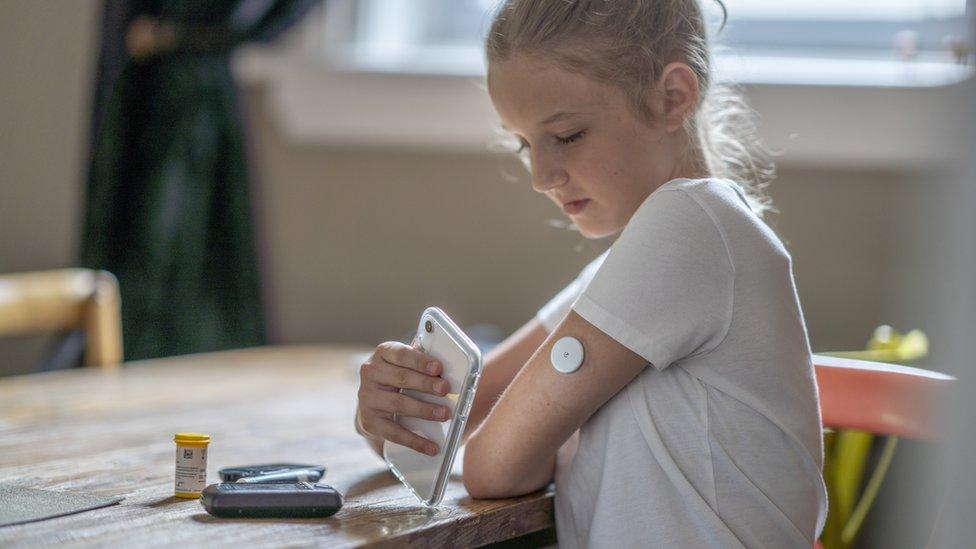Type-2 diabetes: Children to be offered one of two 'life-changing' methods to manage disease
- Published
- comments

The smartphone technology allows a person with diabetes to look at real-time data on how much sugar is in their blood
Mobile phone technology that can help people check insulin levels is being recommended for children with type-2 diabetes for the first time.
Instead of having to test regular blood samples by pricking their finger, the National Institute for Healthcare and Excellence (NICE) have said that kids can now use one of two options that give real-time data on a person's blood sugar and insulin levels on their smartphone.
These are already recommended for children with type-1 diabetes.
The NICE diabetes guidelines already recommended this tech for kids with type-1 diabetes, and now it includes type-2
Research by NICE has found these methods make it easier for people to manage their diabetes.
Dr Judith Richardson, programme director in the Clinical Directorate at NICE, said these recommendations are a "clear step towards giving children on insulin therapy the ability to manage their own condition in a less invasive way, and to live happier and healthier lives."
But what is diabetes, and how do these newly-recommended technologies work? Read on to find out.
What is diabetes?
Lots more children are being diagnosed with type-2 diabetes than before so NICE hopes this will be a real help to them
Diabetes is a condition that causes a person's blood sugar level to become too high.
Having too much sugar (or glucose) in your blood can make you really poorly.
There are two different types:
Type-1 occurs when your body attacks the insulin you create.
Type-2 develops when a person has too little insulin, or their body doesn't use it efficiently.
Because of this, people with diabetes need to constantly measure the amount of sugar in their blood, and in some cases top up the insulin in their body with injections.
Insulin is a hormone that is produced by an organ called the pancreas (this is just behind your stomach)
It is needed in the body to control how much sugar is in your blood
How is diabetes usually monitored?
Up until now, the primary method for checking blood-glucose levels has been finger-pricking to get blood samples
Up until now, people with type-2 diabetes have had take blood samples by pricking their finger with a needle at regular intervals in the day.
This can be tricky to remember to do all the time, and some people don't find it very pleasant.
What is NICE now recommending?
There are two options that NICE are now recommending to children with type-2 diabetes: real-time continuous glucose monitoring (rtCGM) or intermittently scanned glucose monitoring (isCGM).
In both cases, a sensor is attached somewhere on the body - which often looks like a white disc - which connects to a smartphone.
The sensor then sends information that a person can access through an app, such as your current blood-sugar levels, what they've been like over the last few days, and predictions of when and by how much they'll go down.
NICE said that both options make it easier to manage diabetes.
Dr Judith Richardson said this new tech can "take away the burdensome task of several finger prick tests a day, which can be tiring, stressful and have a negative psychological impact on the child."
Professor Partha Kar OBE, the national specialty advisor for diabetes at NHS England, said the technology is "life-changing".
Who is eligible?
A committee has said the technology should be offered to children and young people with diabetes who:
Have a need, condition or disability that means they cannot monitor their blood glucose by finger prick testing
Would need to test at least eight times a day
Often have or low blood sugar levels
Have severe low blood sugar levels
Have difficulty staying aware of their blood sugar levels
- Published1 April 2019
- Published26 January 2021
- Published12 October 2017
